Energy Efficiency Report: Air Conditioner Alternatives Analysis
VerifiedAdded on 2023/06/03
|10
|1716
|499
Report
AI Summary
This report provides an analysis of energy efficiency, specifically focusing on air conditioners and their impact on energy consumption. It begins with an executive summary and introduction outlining the problem of high energy usage by air conditioners. The report then delves into relevant information about air conditioners, including energy consumption rates and alternative cooling systems like evaporative coolers and geothermal systems. It explores various sources of energy, such as gas, coal, electricity, and solar energy, and discusses the organizations responsible for promoting energy efficiency. The report identifies opportunities for reducing energy consumption, such as using air conditioners with higher energy ratings. A cost-benefit analysis is presented, comparing the installation and operational costs of different cooling systems. The conclusion summarizes the findings, highlighting the advantages and disadvantages of each alternative. The report emphasizes the importance of energy-efficient solutions and provides references to support its analysis.
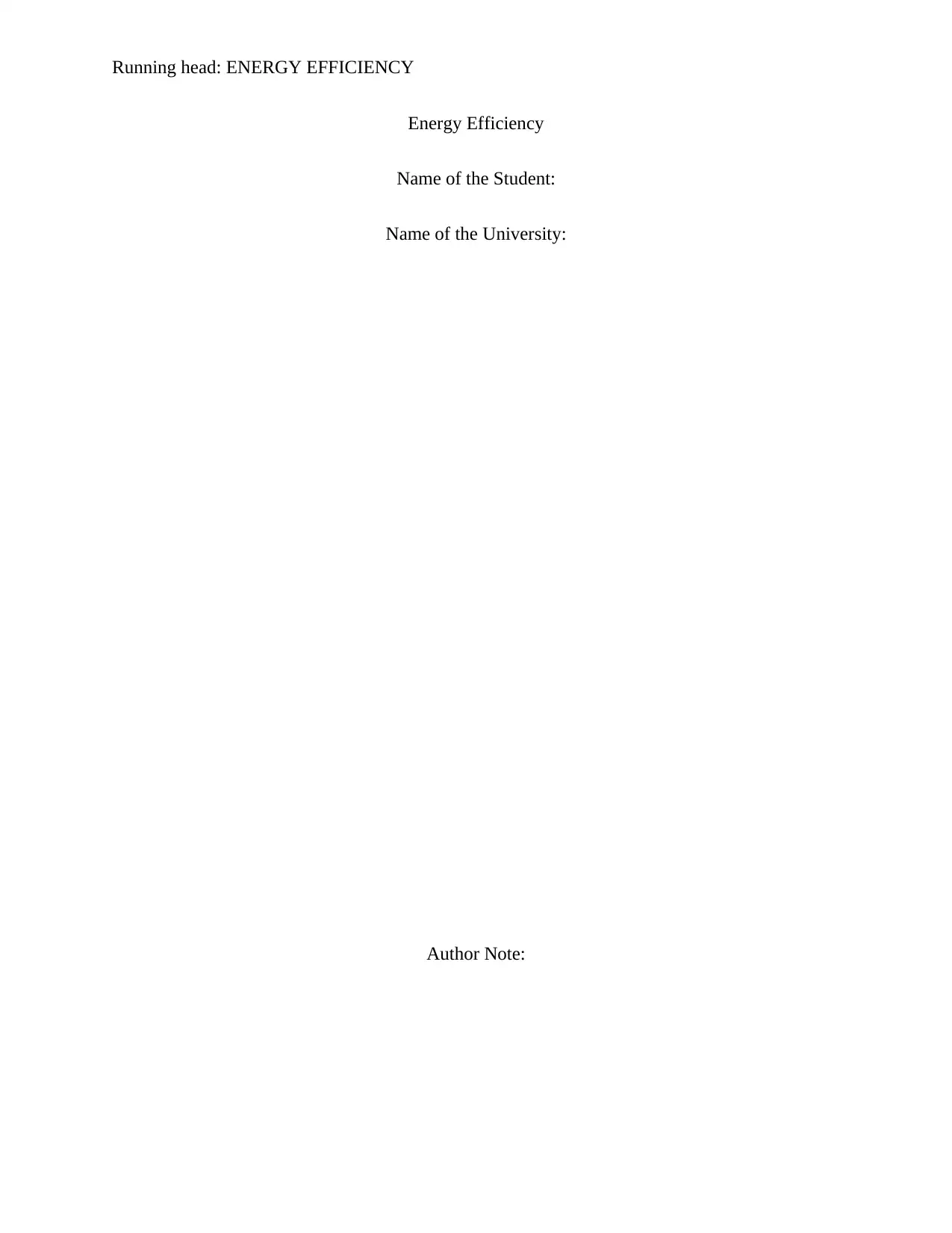
Running head: ENERGY EFFICIENCY
Energy Efficiency
Name of the Student:
Name of the University:
Author Note:
Energy Efficiency
Name of the Student:
Name of the University:
Author Note:
Paraphrase This Document
Need a fresh take? Get an instant paraphrase of this document with our AI Paraphraser
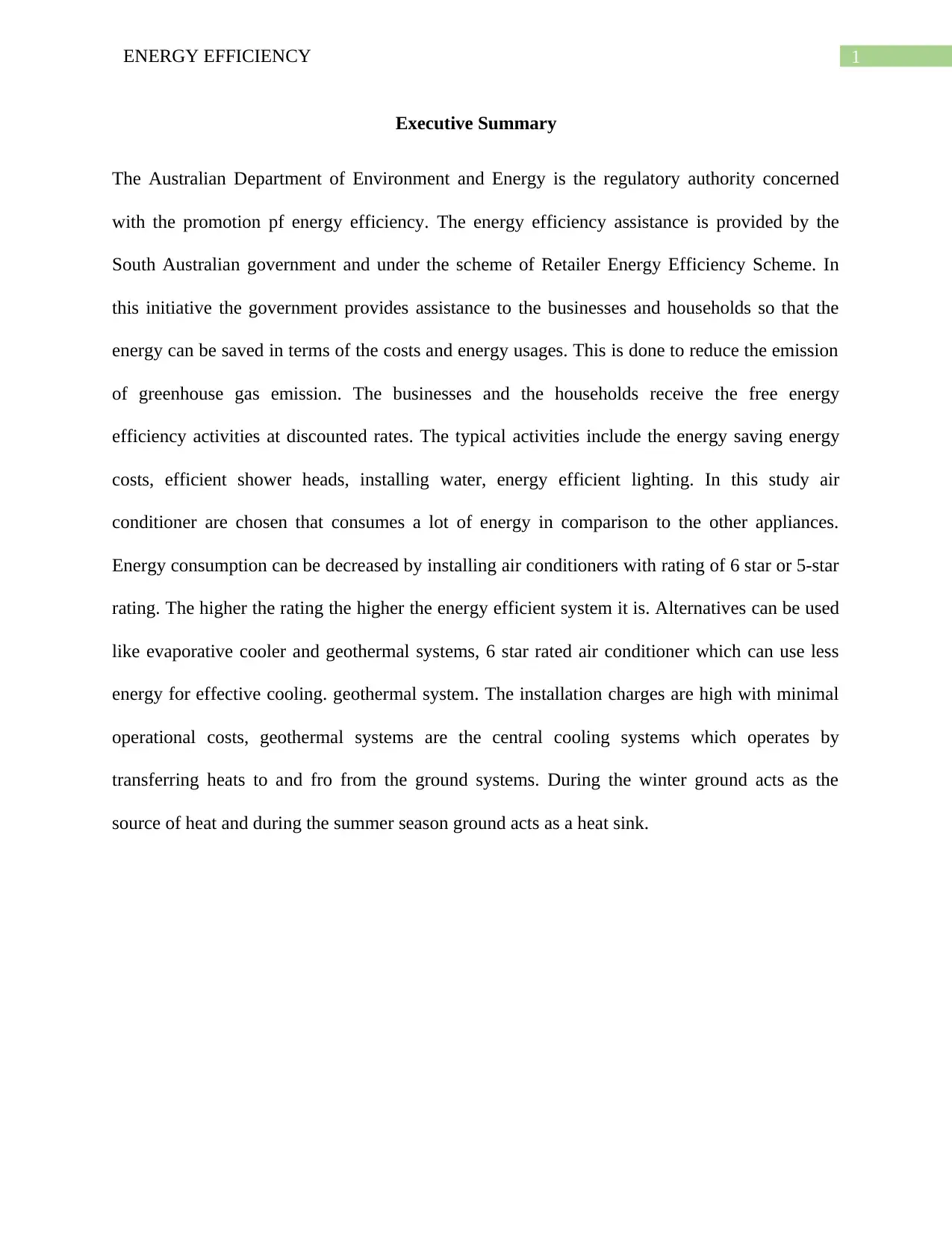
1ENERGY EFFICIENCY
Executive Summary
The Australian Department of Environment and Energy is the regulatory authority concerned
with the promotion pf energy efficiency. The energy efficiency assistance is provided by the
South Australian government and under the scheme of Retailer Energy Efficiency Scheme. In
this initiative the government provides assistance to the businesses and households so that the
energy can be saved in terms of the costs and energy usages. This is done to reduce the emission
of greenhouse gas emission. The businesses and the households receive the free energy
efficiency activities at discounted rates. The typical activities include the energy saving energy
costs, efficient shower heads, installing water, energy efficient lighting. In this study air
conditioner are chosen that consumes a lot of energy in comparison to the other appliances.
Energy consumption can be decreased by installing air conditioners with rating of 6 star or 5-star
rating. The higher the rating the higher the energy efficient system it is. Alternatives can be used
like evaporative cooler and geothermal systems, 6 star rated air conditioner which can use less
energy for effective cooling. geothermal system. The installation charges are high with minimal
operational costs, geothermal systems are the central cooling systems which operates by
transferring heats to and fro from the ground systems. During the winter ground acts as the
source of heat and during the summer season ground acts as a heat sink.
Executive Summary
The Australian Department of Environment and Energy is the regulatory authority concerned
with the promotion pf energy efficiency. The energy efficiency assistance is provided by the
South Australian government and under the scheme of Retailer Energy Efficiency Scheme. In
this initiative the government provides assistance to the businesses and households so that the
energy can be saved in terms of the costs and energy usages. This is done to reduce the emission
of greenhouse gas emission. The businesses and the households receive the free energy
efficiency activities at discounted rates. The typical activities include the energy saving energy
costs, efficient shower heads, installing water, energy efficient lighting. In this study air
conditioner are chosen that consumes a lot of energy in comparison to the other appliances.
Energy consumption can be decreased by installing air conditioners with rating of 6 star or 5-star
rating. The higher the rating the higher the energy efficient system it is. Alternatives can be used
like evaporative cooler and geothermal systems, 6 star rated air conditioner which can use less
energy for effective cooling. geothermal system. The installation charges are high with minimal
operational costs, geothermal systems are the central cooling systems which operates by
transferring heats to and fro from the ground systems. During the winter ground acts as the
source of heat and during the summer season ground acts as a heat sink.
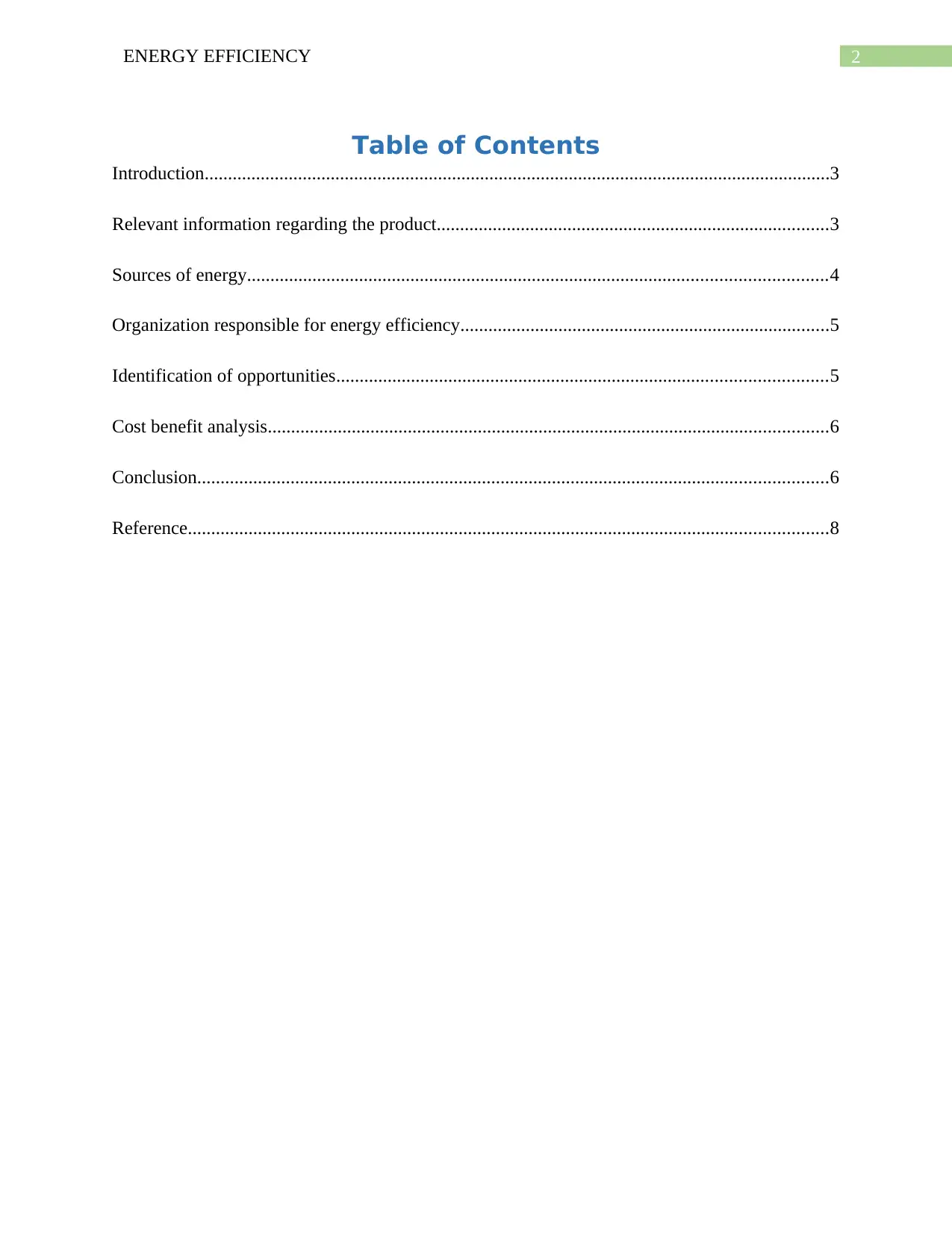
2ENERGY EFFICIENCY
Table of Contents
Introduction......................................................................................................................................3
Relevant information regarding the product....................................................................................3
Sources of energy............................................................................................................................4
Organization responsible for energy efficiency...............................................................................5
Identification of opportunities.........................................................................................................5
Cost benefit analysis........................................................................................................................6
Conclusion.......................................................................................................................................6
Reference.........................................................................................................................................8
Table of Contents
Introduction......................................................................................................................................3
Relevant information regarding the product....................................................................................3
Sources of energy............................................................................................................................4
Organization responsible for energy efficiency...............................................................................5
Identification of opportunities.........................................................................................................5
Cost benefit analysis........................................................................................................................6
Conclusion.......................................................................................................................................6
Reference.........................................................................................................................................8
⊘ This is a preview!⊘
Do you want full access?
Subscribe today to unlock all pages.

Trusted by 1+ million students worldwide
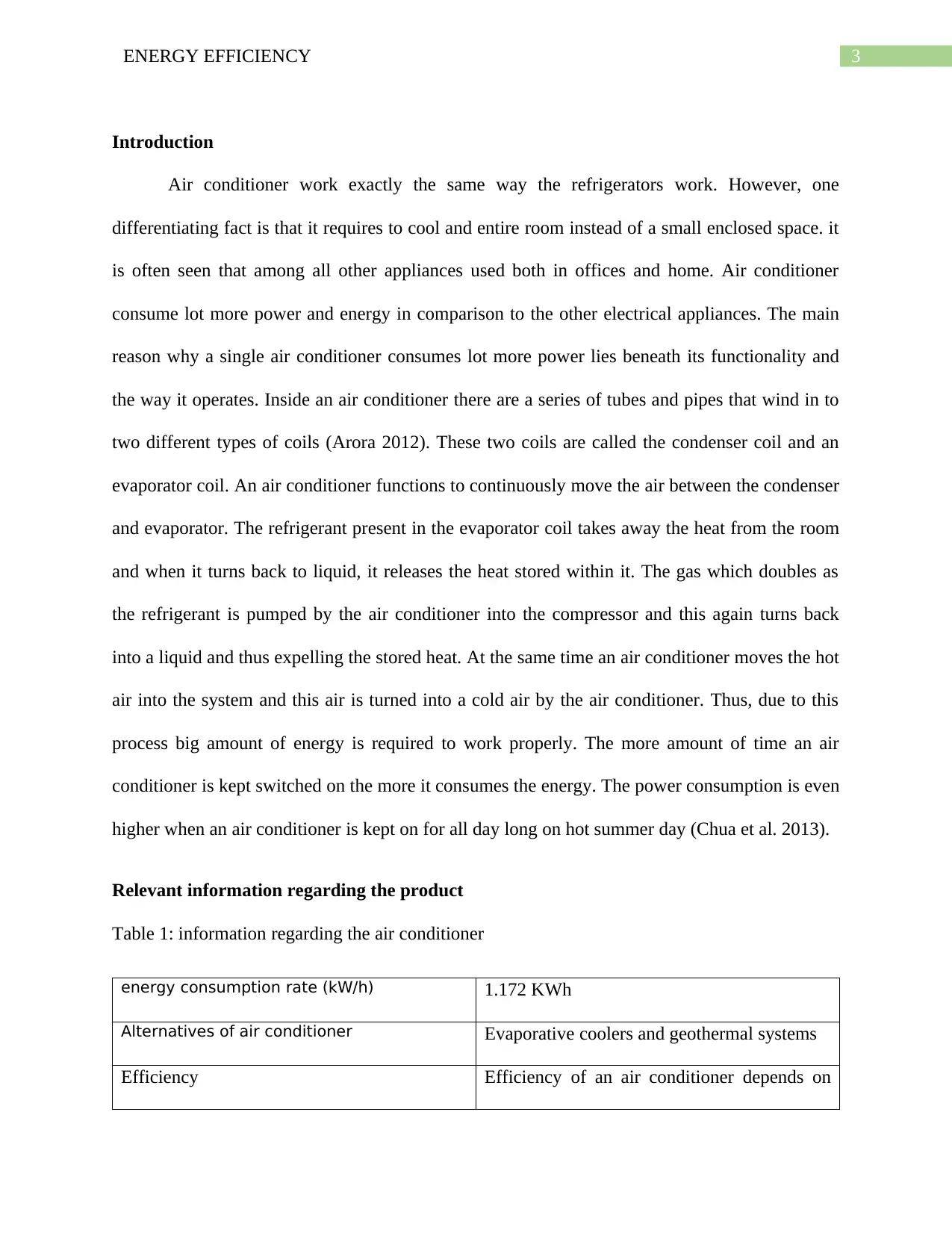
3ENERGY EFFICIENCY
Introduction
Air conditioner work exactly the same way the refrigerators work. However, one
differentiating fact is that it requires to cool and entire room instead of a small enclosed space. it
is often seen that among all other appliances used both in offices and home. Air conditioner
consume lot more power and energy in comparison to the other electrical appliances. The main
reason why a single air conditioner consumes lot more power lies beneath its functionality and
the way it operates. Inside an air conditioner there are a series of tubes and pipes that wind in to
two different types of coils (Arora 2012). These two coils are called the condenser coil and an
evaporator coil. An air conditioner functions to continuously move the air between the condenser
and evaporator. The refrigerant present in the evaporator coil takes away the heat from the room
and when it turns back to liquid, it releases the heat stored within it. The gas which doubles as
the refrigerant is pumped by the air conditioner into the compressor and this again turns back
into a liquid and thus expelling the stored heat. At the same time an air conditioner moves the hot
air into the system and this air is turned into a cold air by the air conditioner. Thus, due to this
process big amount of energy is required to work properly. The more amount of time an air
conditioner is kept switched on the more it consumes the energy. The power consumption is even
higher when an air conditioner is kept on for all day long on hot summer day (Chua et al. 2013).
Relevant information regarding the product
Table 1: information regarding the air conditioner
energy consumption rate (kW/h) 1.172 KWh
Alternatives of air conditioner Evaporative coolers and geothermal systems
Efficiency Efficiency of an air conditioner depends on
Introduction
Air conditioner work exactly the same way the refrigerators work. However, one
differentiating fact is that it requires to cool and entire room instead of a small enclosed space. it
is often seen that among all other appliances used both in offices and home. Air conditioner
consume lot more power and energy in comparison to the other electrical appliances. The main
reason why a single air conditioner consumes lot more power lies beneath its functionality and
the way it operates. Inside an air conditioner there are a series of tubes and pipes that wind in to
two different types of coils (Arora 2012). These two coils are called the condenser coil and an
evaporator coil. An air conditioner functions to continuously move the air between the condenser
and evaporator. The refrigerant present in the evaporator coil takes away the heat from the room
and when it turns back to liquid, it releases the heat stored within it. The gas which doubles as
the refrigerant is pumped by the air conditioner into the compressor and this again turns back
into a liquid and thus expelling the stored heat. At the same time an air conditioner moves the hot
air into the system and this air is turned into a cold air by the air conditioner. Thus, due to this
process big amount of energy is required to work properly. The more amount of time an air
conditioner is kept switched on the more it consumes the energy. The power consumption is even
higher when an air conditioner is kept on for all day long on hot summer day (Chua et al. 2013).
Relevant information regarding the product
Table 1: information regarding the air conditioner
energy consumption rate (kW/h) 1.172 KWh
Alternatives of air conditioner Evaporative coolers and geothermal systems
Efficiency Efficiency of an air conditioner depends on
Paraphrase This Document
Need a fresh take? Get an instant paraphrase of this document with our AI Paraphraser
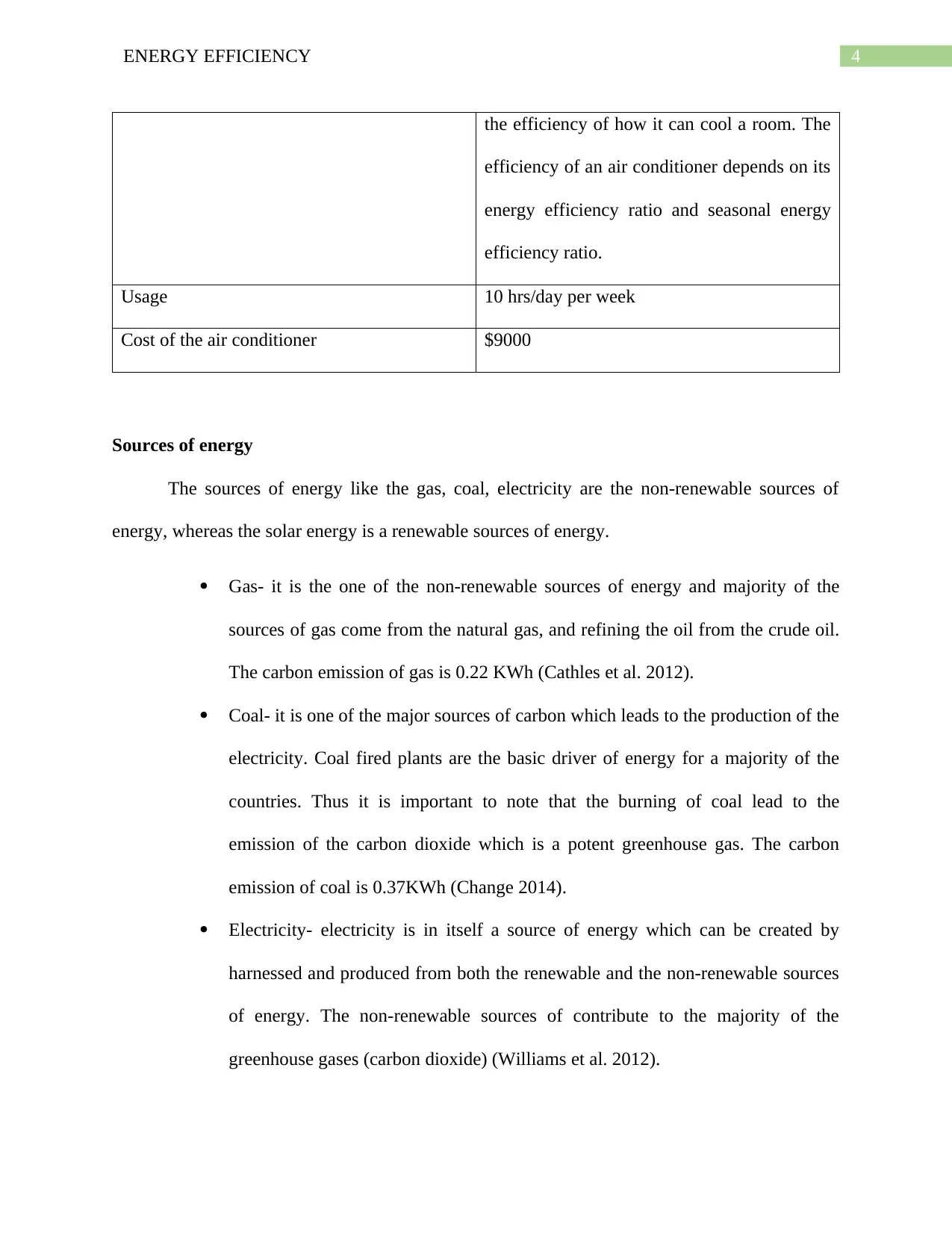
4ENERGY EFFICIENCY
the efficiency of how it can cool a room. The
efficiency of an air conditioner depends on its
energy efficiency ratio and seasonal energy
efficiency ratio.
Usage 10 hrs/day per week
Cost of the air conditioner $9000
Sources of energy
The sources of energy like the gas, coal, electricity are the non-renewable sources of
energy, whereas the solar energy is a renewable sources of energy.
Gas- it is the one of the non-renewable sources of energy and majority of the
sources of gas come from the natural gas, and refining the oil from the crude oil.
The carbon emission of gas is 0.22 KWh (Cathles et al. 2012).
Coal- it is one of the major sources of carbon which leads to the production of the
electricity. Coal fired plants are the basic driver of energy for a majority of the
countries. Thus it is important to note that the burning of coal lead to the
emission of the carbon dioxide which is a potent greenhouse gas. The carbon
emission of coal is 0.37KWh (Change 2014).
Electricity- electricity is in itself a source of energy which can be created by
harnessed and produced from both the renewable and the non-renewable sources
of energy. The non-renewable sources of contribute to the majority of the
greenhouse gases (carbon dioxide) (Williams et al. 2012).
the efficiency of how it can cool a room. The
efficiency of an air conditioner depends on its
energy efficiency ratio and seasonal energy
efficiency ratio.
Usage 10 hrs/day per week
Cost of the air conditioner $9000
Sources of energy
The sources of energy like the gas, coal, electricity are the non-renewable sources of
energy, whereas the solar energy is a renewable sources of energy.
Gas- it is the one of the non-renewable sources of energy and majority of the
sources of gas come from the natural gas, and refining the oil from the crude oil.
The carbon emission of gas is 0.22 KWh (Cathles et al. 2012).
Coal- it is one of the major sources of carbon which leads to the production of the
electricity. Coal fired plants are the basic driver of energy for a majority of the
countries. Thus it is important to note that the burning of coal lead to the
emission of the carbon dioxide which is a potent greenhouse gas. The carbon
emission of coal is 0.37KWh (Change 2014).
Electricity- electricity is in itself a source of energy which can be created by
harnessed and produced from both the renewable and the non-renewable sources
of energy. The non-renewable sources of contribute to the majority of the
greenhouse gases (carbon dioxide) (Williams et al. 2012).
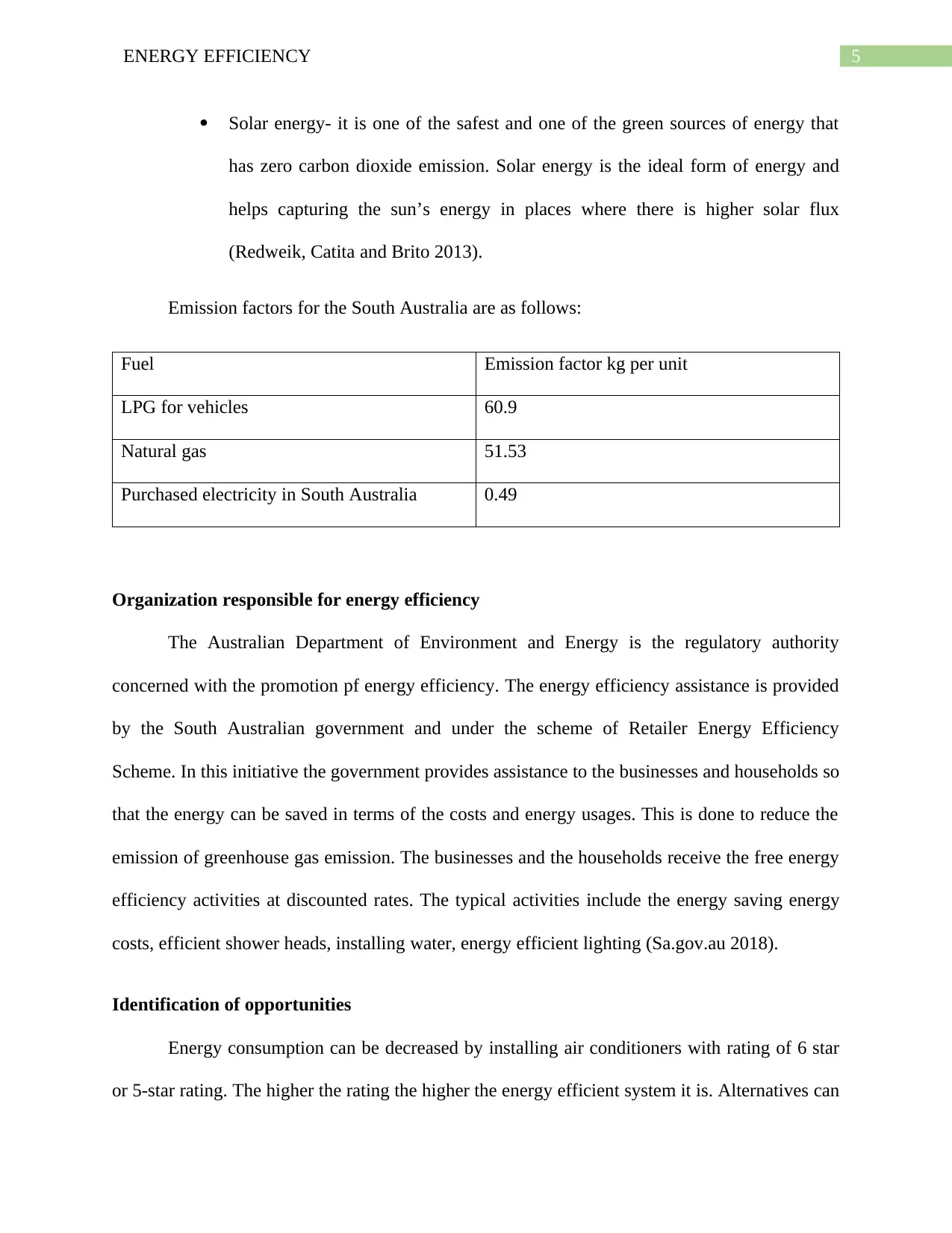
5ENERGY EFFICIENCY
Solar energy- it is one of the safest and one of the green sources of energy that
has zero carbon dioxide emission. Solar energy is the ideal form of energy and
helps capturing the sun’s energy in places where there is higher solar flux
(Redweik, Catita and Brito 2013).
Emission factors for the South Australia are as follows:
Fuel Emission factor kg per unit
LPG for vehicles 60.9
Natural gas 51.53
Purchased electricity in South Australia 0.49
Organization responsible for energy efficiency
The Australian Department of Environment and Energy is the regulatory authority
concerned with the promotion pf energy efficiency. The energy efficiency assistance is provided
by the South Australian government and under the scheme of Retailer Energy Efficiency
Scheme. In this initiative the government provides assistance to the businesses and households so
that the energy can be saved in terms of the costs and energy usages. This is done to reduce the
emission of greenhouse gas emission. The businesses and the households receive the free energy
efficiency activities at discounted rates. The typical activities include the energy saving energy
costs, efficient shower heads, installing water, energy efficient lighting (Sa.gov.au 2018).
Identification of opportunities
Energy consumption can be decreased by installing air conditioners with rating of 6 star
or 5-star rating. The higher the rating the higher the energy efficient system it is. Alternatives can
Solar energy- it is one of the safest and one of the green sources of energy that
has zero carbon dioxide emission. Solar energy is the ideal form of energy and
helps capturing the sun’s energy in places where there is higher solar flux
(Redweik, Catita and Brito 2013).
Emission factors for the South Australia are as follows:
Fuel Emission factor kg per unit
LPG for vehicles 60.9
Natural gas 51.53
Purchased electricity in South Australia 0.49
Organization responsible for energy efficiency
The Australian Department of Environment and Energy is the regulatory authority
concerned with the promotion pf energy efficiency. The energy efficiency assistance is provided
by the South Australian government and under the scheme of Retailer Energy Efficiency
Scheme. In this initiative the government provides assistance to the businesses and households so
that the energy can be saved in terms of the costs and energy usages. This is done to reduce the
emission of greenhouse gas emission. The businesses and the households receive the free energy
efficiency activities at discounted rates. The typical activities include the energy saving energy
costs, efficient shower heads, installing water, energy efficient lighting (Sa.gov.au 2018).
Identification of opportunities
Energy consumption can be decreased by installing air conditioners with rating of 6 star
or 5-star rating. The higher the rating the higher the energy efficient system it is. Alternatives can
⊘ This is a preview!⊘
Do you want full access?
Subscribe today to unlock all pages.

Trusted by 1+ million students worldwide
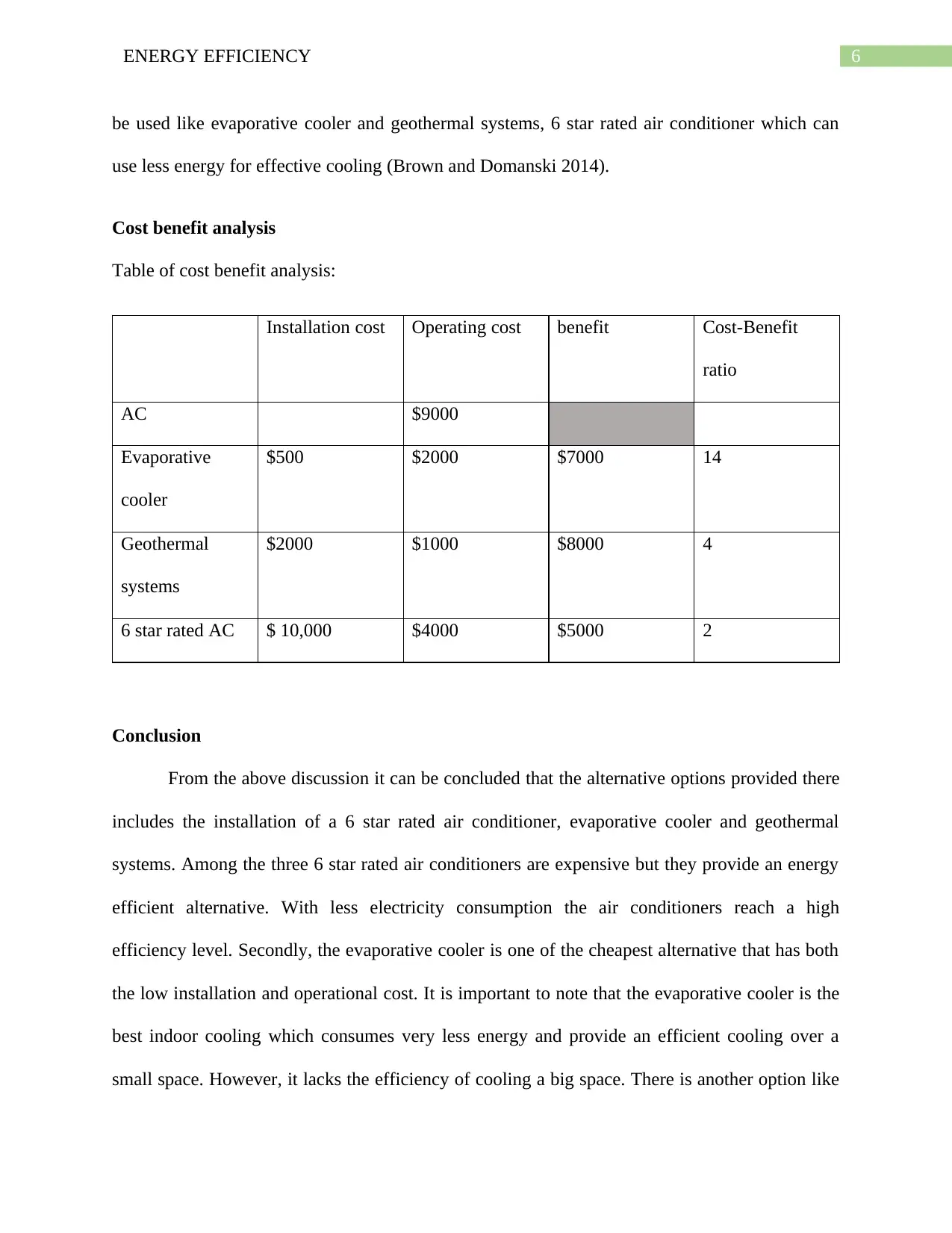
6ENERGY EFFICIENCY
be used like evaporative cooler and geothermal systems, 6 star rated air conditioner which can
use less energy for effective cooling (Brown and Domanski 2014).
Cost benefit analysis
Table of cost benefit analysis:
Installation cost Operating cost benefit Cost-Benefit
ratio
AC $9000
Evaporative
cooler
$500 $2000 $7000 14
Geothermal
systems
$2000 $1000 $8000 4
6 star rated AC $ 10,000 $4000 $5000 2
Conclusion
From the above discussion it can be concluded that the alternative options provided there
includes the installation of a 6 star rated air conditioner, evaporative cooler and geothermal
systems. Among the three 6 star rated air conditioners are expensive but they provide an energy
efficient alternative. With less electricity consumption the air conditioners reach a high
efficiency level. Secondly, the evaporative cooler is one of the cheapest alternative that has both
the low installation and operational cost. It is important to note that the evaporative cooler is the
best indoor cooling which consumes very less energy and provide an efficient cooling over a
small space. However, it lacks the efficiency of cooling a big space. There is another option like
be used like evaporative cooler and geothermal systems, 6 star rated air conditioner which can
use less energy for effective cooling (Brown and Domanski 2014).
Cost benefit analysis
Table of cost benefit analysis:
Installation cost Operating cost benefit Cost-Benefit
ratio
AC $9000
Evaporative
cooler
$500 $2000 $7000 14
Geothermal
systems
$2000 $1000 $8000 4
6 star rated AC $ 10,000 $4000 $5000 2
Conclusion
From the above discussion it can be concluded that the alternative options provided there
includes the installation of a 6 star rated air conditioner, evaporative cooler and geothermal
systems. Among the three 6 star rated air conditioners are expensive but they provide an energy
efficient alternative. With less electricity consumption the air conditioners reach a high
efficiency level. Secondly, the evaporative cooler is one of the cheapest alternative that has both
the low installation and operational cost. It is important to note that the evaporative cooler is the
best indoor cooling which consumes very less energy and provide an efficient cooling over a
small space. However, it lacks the efficiency of cooling a big space. There is another option like
Paraphrase This Document
Need a fresh take? Get an instant paraphrase of this document with our AI Paraphraser
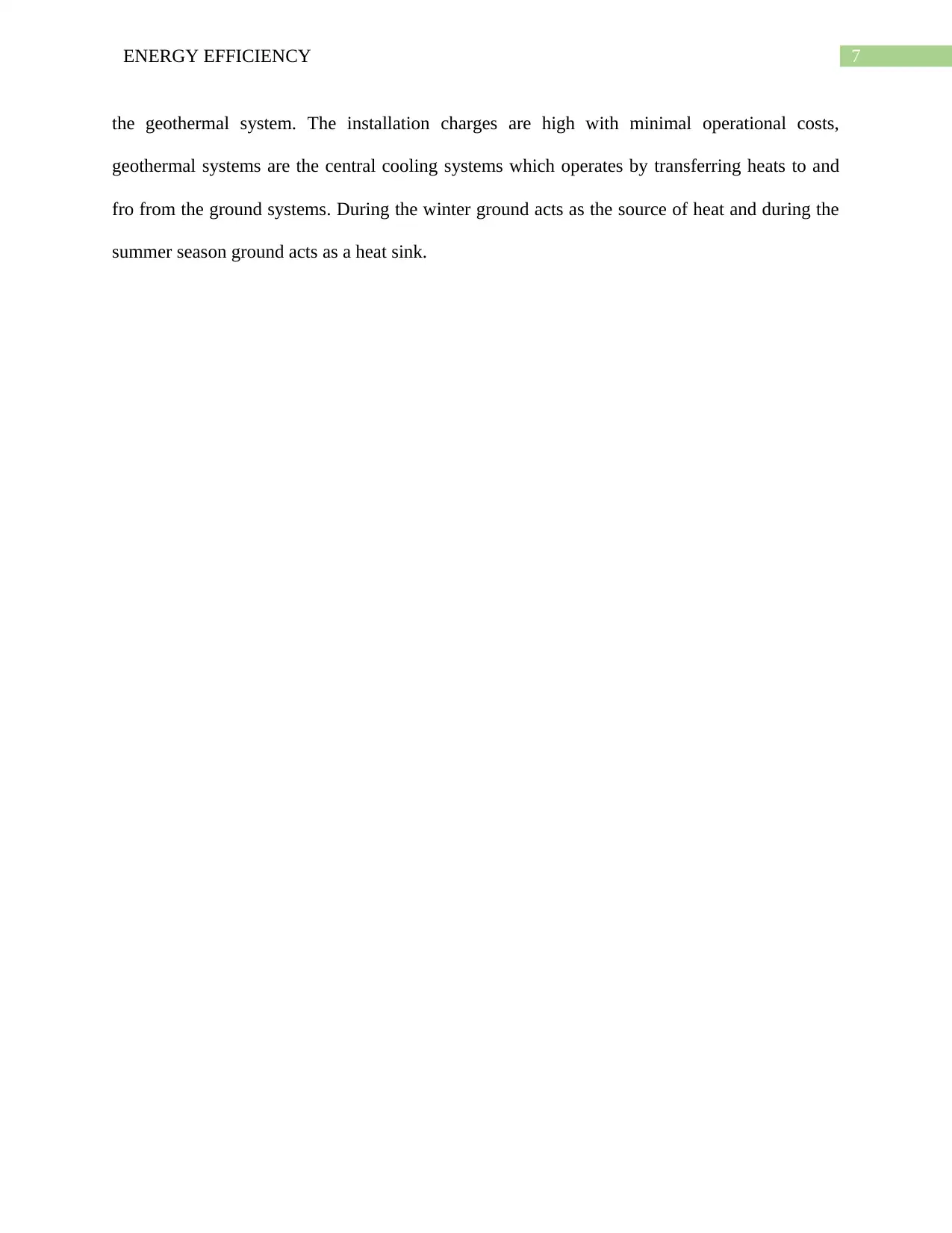
7ENERGY EFFICIENCY
the geothermal system. The installation charges are high with minimal operational costs,
geothermal systems are the central cooling systems which operates by transferring heats to and
fro from the ground systems. During the winter ground acts as the source of heat and during the
summer season ground acts as a heat sink.
the geothermal system. The installation charges are high with minimal operational costs,
geothermal systems are the central cooling systems which operates by transferring heats to and
fro from the ground systems. During the winter ground acts as the source of heat and during the
summer season ground acts as a heat sink.
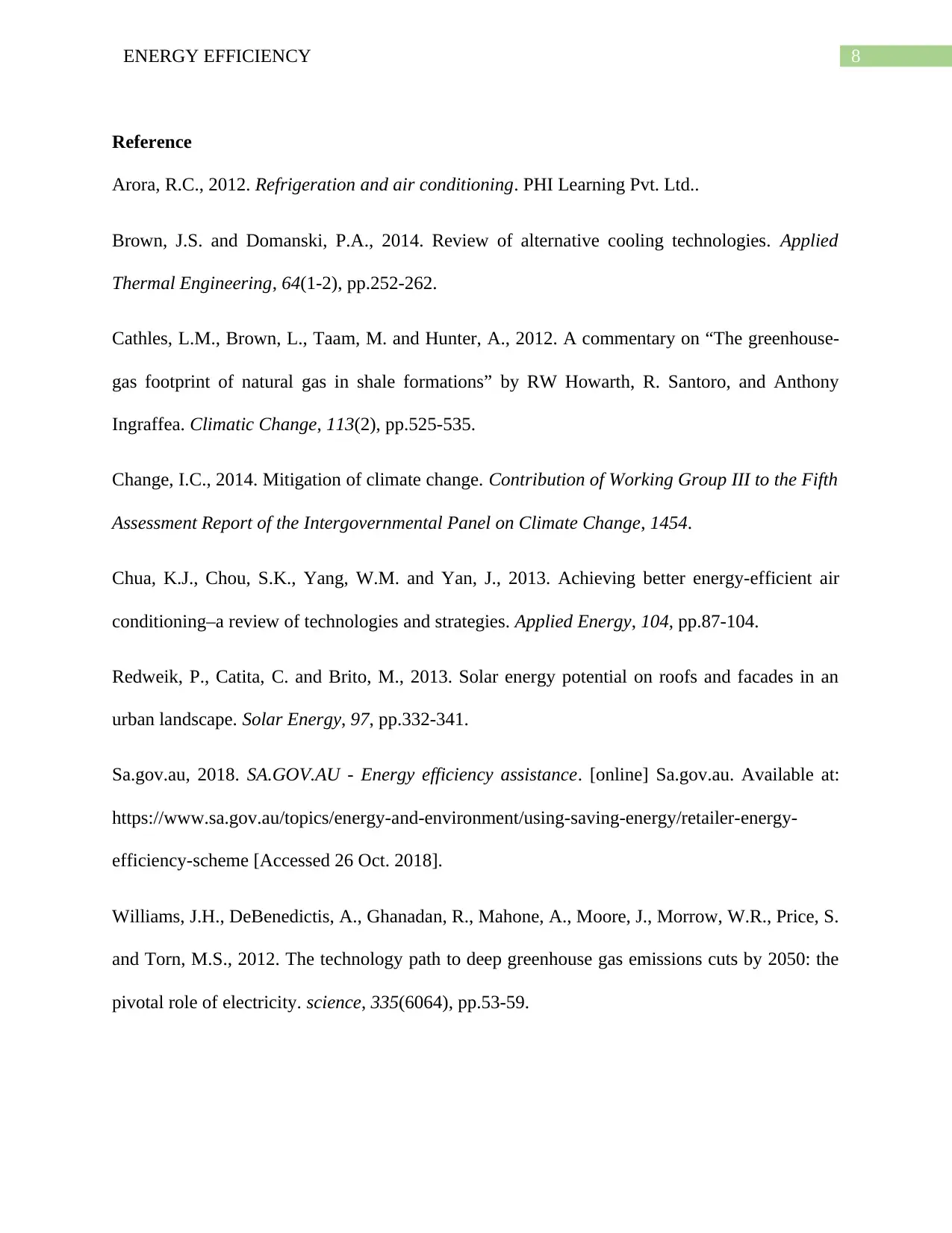
8ENERGY EFFICIENCY
Reference
Arora, R.C., 2012. Refrigeration and air conditioning. PHI Learning Pvt. Ltd..
Brown, J.S. and Domanski, P.A., 2014. Review of alternative cooling technologies. Applied
Thermal Engineering, 64(1-2), pp.252-262.
Cathles, L.M., Brown, L., Taam, M. and Hunter, A., 2012. A commentary on “The greenhouse-
gas footprint of natural gas in shale formations” by RW Howarth, R. Santoro, and Anthony
Ingraffea. Climatic Change, 113(2), pp.525-535.
Change, I.C., 2014. Mitigation of climate change. Contribution of Working Group III to the Fifth
Assessment Report of the Intergovernmental Panel on Climate Change, 1454.
Chua, K.J., Chou, S.K., Yang, W.M. and Yan, J., 2013. Achieving better energy-efficient air
conditioning–a review of technologies and strategies. Applied Energy, 104, pp.87-104.
Redweik, P., Catita, C. and Brito, M., 2013. Solar energy potential on roofs and facades in an
urban landscape. Solar Energy, 97, pp.332-341.
Sa.gov.au, 2018. SA.GOV.AU - Energy efficiency assistance. [online] Sa.gov.au. Available at:
https://www.sa.gov.au/topics/energy-and-environment/using-saving-energy/retailer-energy-
efficiency-scheme [Accessed 26 Oct. 2018].
Williams, J.H., DeBenedictis, A., Ghanadan, R., Mahone, A., Moore, J., Morrow, W.R., Price, S.
and Torn, M.S., 2012. The technology path to deep greenhouse gas emissions cuts by 2050: the
pivotal role of electricity. science, 335(6064), pp.53-59.
Reference
Arora, R.C., 2012. Refrigeration and air conditioning. PHI Learning Pvt. Ltd..
Brown, J.S. and Domanski, P.A., 2014. Review of alternative cooling technologies. Applied
Thermal Engineering, 64(1-2), pp.252-262.
Cathles, L.M., Brown, L., Taam, M. and Hunter, A., 2012. A commentary on “The greenhouse-
gas footprint of natural gas in shale formations” by RW Howarth, R. Santoro, and Anthony
Ingraffea. Climatic Change, 113(2), pp.525-535.
Change, I.C., 2014. Mitigation of climate change. Contribution of Working Group III to the Fifth
Assessment Report of the Intergovernmental Panel on Climate Change, 1454.
Chua, K.J., Chou, S.K., Yang, W.M. and Yan, J., 2013. Achieving better energy-efficient air
conditioning–a review of technologies and strategies. Applied Energy, 104, pp.87-104.
Redweik, P., Catita, C. and Brito, M., 2013. Solar energy potential on roofs and facades in an
urban landscape. Solar Energy, 97, pp.332-341.
Sa.gov.au, 2018. SA.GOV.AU - Energy efficiency assistance. [online] Sa.gov.au. Available at:
https://www.sa.gov.au/topics/energy-and-environment/using-saving-energy/retailer-energy-
efficiency-scheme [Accessed 26 Oct. 2018].
Williams, J.H., DeBenedictis, A., Ghanadan, R., Mahone, A., Moore, J., Morrow, W.R., Price, S.
and Torn, M.S., 2012. The technology path to deep greenhouse gas emissions cuts by 2050: the
pivotal role of electricity. science, 335(6064), pp.53-59.
⊘ This is a preview!⊘
Do you want full access?
Subscribe today to unlock all pages.

Trusted by 1+ million students worldwide
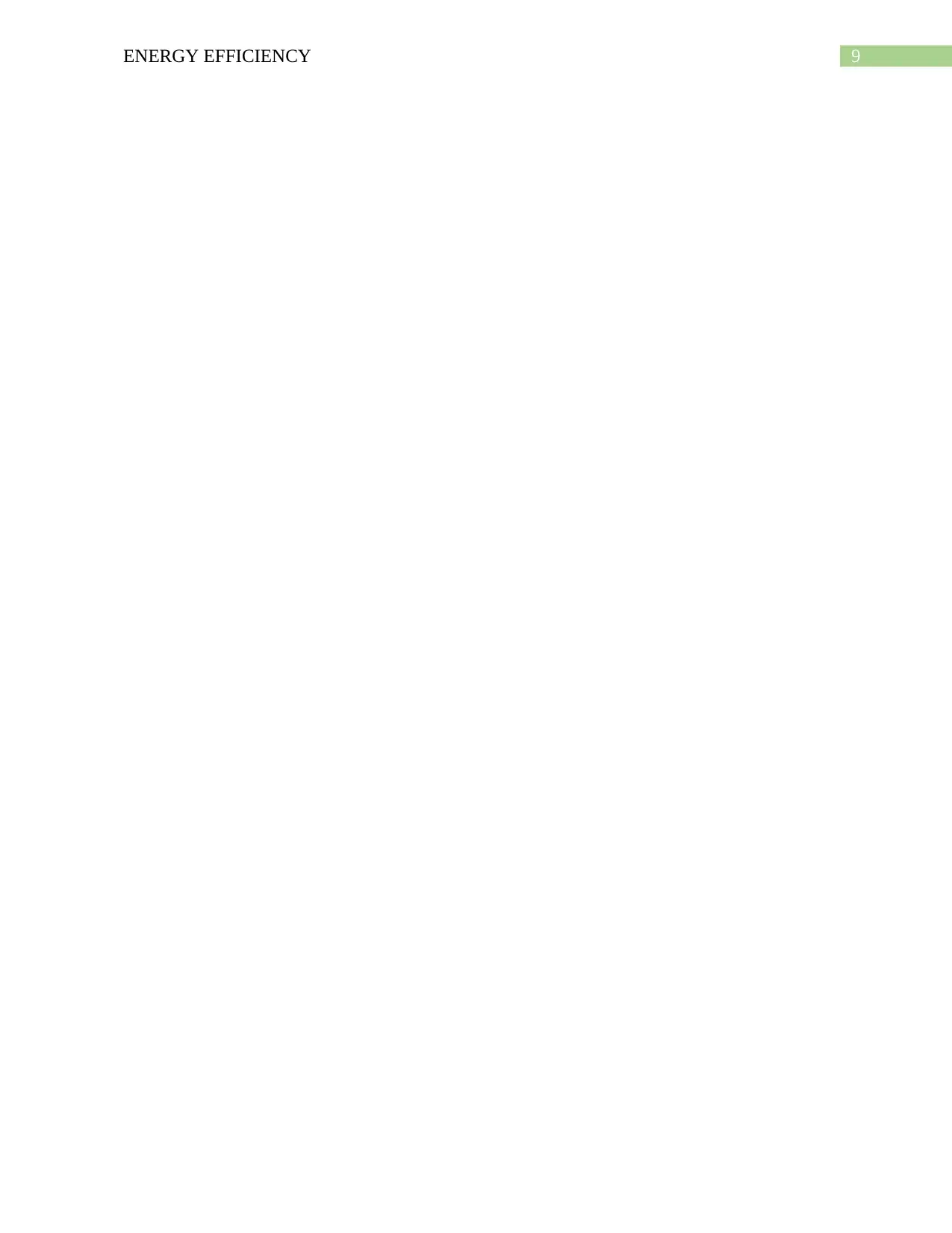
9ENERGY EFFICIENCY
1 out of 10
Related Documents
Your All-in-One AI-Powered Toolkit for Academic Success.
+13062052269
info@desklib.com
Available 24*7 on WhatsApp / Email
![[object Object]](/_next/static/media/star-bottom.7253800d.svg)
Unlock your academic potential
Copyright © 2020–2025 A2Z Services. All Rights Reserved. Developed and managed by ZUCOL.





